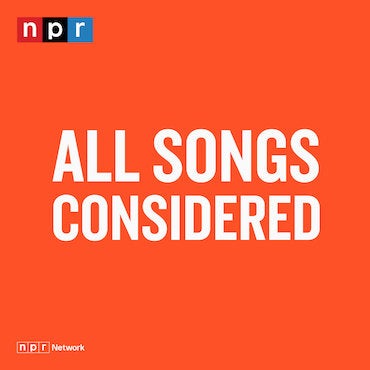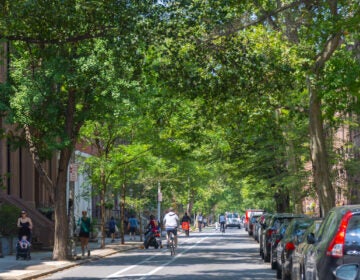Broad Street divided on Spruce and Pine bike lane remake
A crowd of nearly 150 braved the blustery winds last night to attend an open house on a proposal to move the bike lanes on Pine and Spruce Streets to the left side of the road

Cars regularly stop in Philadelphia's bike lanes that aren't "protected" by delineator posts. (Emma Lee/WHYY)
A crowd of nearly 150 braved the blustery winds Wednesday night to attend an open house on a proposal to move the bike lanes on Pine and Spruce Streets to the left side of those roads.
Not a single attendee among the dozen approached by PlanPhilly said they opposed the move, which planners from the city’s Office of Transportation and Infrastructure Systems (OTIS) say would help prevent crashes between cyclists and turning cars by improving sightlines for drivers. Members of the Center City Residents Association (CCRA) board canvassed the meeting, held at 300 South Broad St. for residents and businesses on the street’s west side, saying they would solicit more feedback before they took a position on the proposal. And while there were undoubtedly a few opponents, almost all of the public comments left on post-it notes were positive.
The crowd will undoubtedly be more hostile when the scene repeats itself Thursday night for an open house on the other side of Broad Street. The meeting for residents and businesses on the east side of Broad will be held at 401 South Broad. In an email to its members last week, the Society Hill Civic Association (SHCA) said it opposes the plan to flip the bike and parking lanes on Pine and Spruce.
The SHCA declined an interview request in advance of Wednesday’s meeting, and two SHCA board members in attendance also declined to comment.
In its email, the SHCA President Rosanne Loesch said city planners “had not made their case,” for swapping the lanes.
In Philadelphia, streetscape decisions are largely made hyper-locally. In 2012, Councilman-at-Large Bill Greenlee passed a bill requiring City Council’s signoff on any road configuration changes that would result in the loss of parking or an automobile travel lane. Thanks to the tradition of Councilmanic prerogative, that essentially gives each district Council member plenary power over street design in their districts. Those Council members, in turn, defer to local Registered Community Organizations (RCOs) such as Center City Residents Association and Society Hill Civic Association on these questions.
While studies have suggested that bike lanes boost property values and benefit local businesses, the nearby neighbors bear most of the external costs from a new bike lane that comes in the form of lost parking. Protecting a bike lane with plastic delineator posts would also restrict the ability to stop a car temporarily in a bike lane for loading and unloading. The benefits — safer travel for cyclists, as well as drivers and pedestrians — largely accrue to people traveling through.
Even if that weren’t enough, there is also simple inertia to overcome: people are, by their very human nature, adverse to change and the uncertainty it can engender.
Outside the meeting, around fifty bike lane supporters formed a human protected bike lane — standing on the painted line of a bike lane — to express their support for improved bike infrastructure.
To the extent attendees Wednesday night were opposed to the proposal, it was for failing to go far enough.
“Unfortunately, we’ve had two major accidents among this corridor last year, one of which resulted in the death of Emily Fredricks,” said James Gitto, one of the protest organizers. “The opportunity for the redesign of the streets came up, and the only thing OTIS did for us is switch the lane to the other side — not that that’s a bad thing, there is more visibility, but data has shown that separating bicyclists and vehicles on the road is better for both.”
“It is unfortunate that OTIS has chosen not to do that,” added Gitto. “It does seem that the reason they are not doing it is moreover the convenience of some than the safety of everyone.”
OTIS deployed an open house style meeting, spreading poster-board displays across a large room and manning each with a city representative to answer questions. Compared to presentations followed by a question-and-answer session, the format engenders one-on-one conversations and limits the amount of yelling that usually distinguishes this kind of meetings.
WHYY is your source for fact-based, in-depth journalism and information. As a nonprofit organization, we rely on financial support from readers like you. Please give today.






